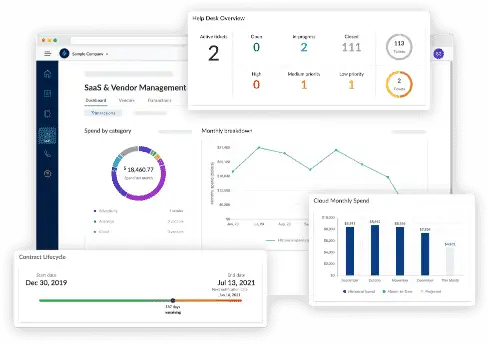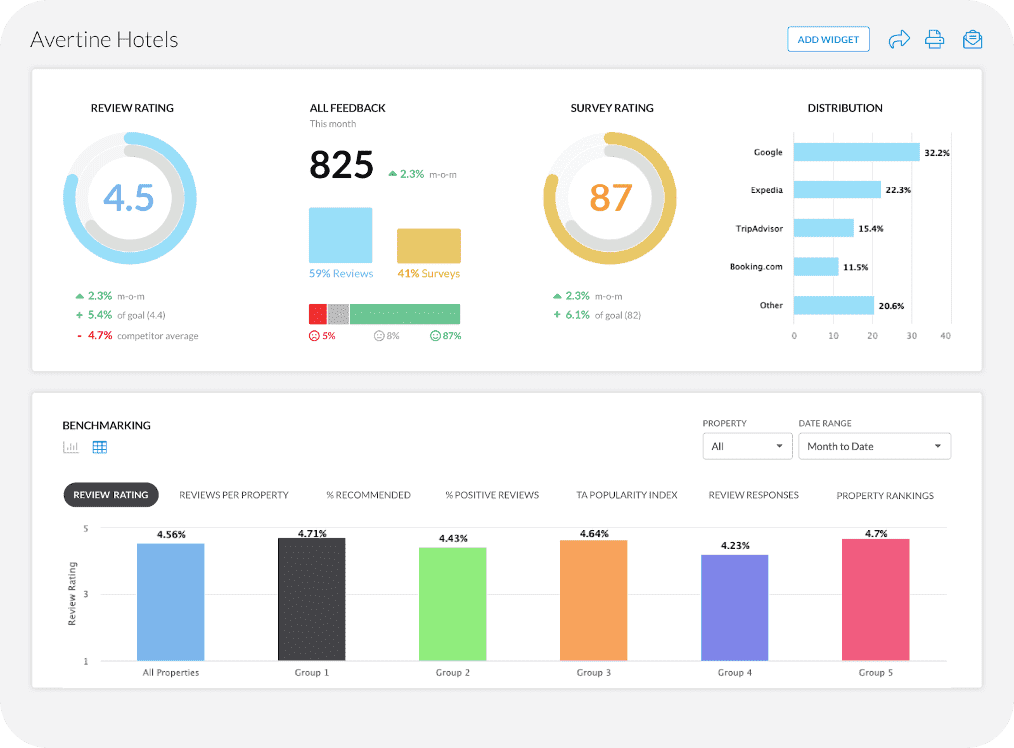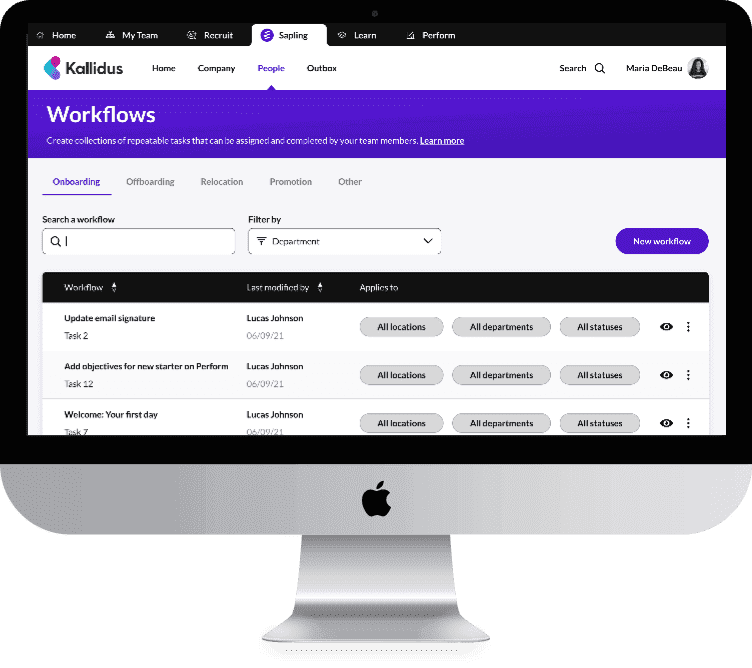When it comes to web frameworks and technologies, React always wins. According to the Stackoverflow Developers Survey 2024, React is ranked # 2 in the web frameworks and technologies ranking.

This proves that React is still popular for building user interfaces, especially for single-page applications. Since the component-based architecture, virtual DOM, and ease of integration with other libraries are crucial for SPAs, React becomes the top choice.
The critical aspect in building SPAs is managing navigation and routing. Traditionally, websites load new HTML pages via the server, while SPAs load a single HTML file and update the content dynamically using JavaScript.
At this point, React Router comes in. It is the standard routing library that allows building dynamic routing in applications while furnishing a smooth user experience.
In this long but knowledgeable article, you will learn the role of React Router in React applications and understand how it works. It doesn’t matter whether you are a skilled developer or a beginner; this article will allow you to understand React Router better and in a new way.
What is a React Router?

As said earlier, React Router is the standard library for React applications that handles the routing processes. It creates dynamic routers and allows easy navigation management by defining routes connecting the URL paths to specific components.
Hence, there’s no need to control route changes and browser history manually, as developers define routes as part of their component tree.
Furthermore, using the React Router, you can implement distinct views for different parts of your application without the need for a full page refresh. This is a key feature of React Routing, which is extremely beneficial for single-page applications. With this, the content is only updated where the user navigates.
Core Concepts in React Router
The core concepts that you must understand in React Router are:
- Route
It is a mapping between a URL and a component. It plays its role when a user visits any URL, the React Router renders the corresponding component.
- Router
The router is responsible for providing the infrastructure for routing. BrowserRouter is used for web applications, whereas HashRouter is for static sites.
- Nested Routes
Like nested loops, React Router provides nested routes that create a hierarchy of components. These play their part in the layout structures.
- Link
The Link component maintains the application’s state. It enables navigation by creating anchor-like elements for maintaining the state of the application.
Types of React Router
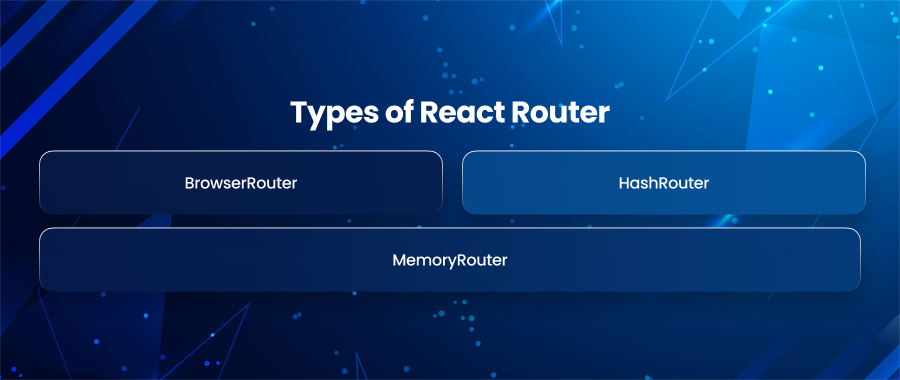
Commonly, there are three types of React Routers:
BrowserRouter
Firstly, we have BrowserRouter. It is the most commonly used type of React Router for modern web applications.
- It uses HTML5 history API to manage the navigation.
- This router type keeps the UI in sync with the URL by using pushState, replaceState, and popState events.
- There are no hash fragments in URLs, which means the URLs are clean and human-readable.
HashRouter
Secondly, there is HashRouter. It is used when you want to use a URL hash (#) for routing. Further, it uses the hash portion of the URL to manage navigation.
- It uses a URL hash to represent various routes.
- The hash part in the URL is not sent to the server. Instead, it is used to change the displayed content in the browser.
- It is useful for static websites for handling navigation.
MemoryRouter
Lastly, the memory router comes into play when there is no web browser. This usually happens in testing or mobile apps. It memorizes the navigation history inside the app but doesn’t change the URL. Hence, this becomes very helpful for testing and no browser environments.
- You will witness no change in the URL in the MemoryRouter. It only stores the location state internally.
- It keeps the navigation history in memory, instead of the URL or browser history. This feature makes it ideal for non-browser environments.
What Makes React Router a Top Routing Library?
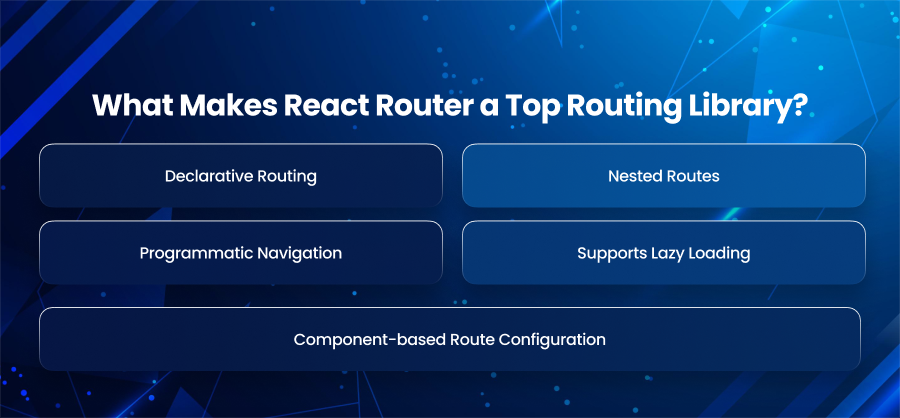
Any tool that takes lead from competitors offers some irresistible features that no one else offers. The same is the case with React Router; the features make it a top-notch React Routing library.
Declarative Routing
The React Router follows a declarative approach. In this approach, the developers define routes as JSX components. With this approach, you improve the readability and allow the router to handle logic internally based on the declared structure.
Nested Routes
With React Router, you can nest the routes within each other and support dynamic segments. This helps you mirror the component tree and creates a natural routing flow.
Programmatic Navigation
React has Hooks such as useNavigate, which enable developers to trigger navigation in response to logic or events.
Component-based Route Configuration
Moreover, there is component-based route configuration in React Router, where each router is represented by a React component. This makes it easier to integrate routing with the component hierarchy. As a result, the routing logic remains modular and reusable.
Supports Lazy Loading
Lastly, it supports lazy loading. With this feature, components use React.lazy and Suspense to only load the routes when needed. This improves the overall performance of the application.
Working of React Router
React Router works by managing your application’s history stack. It matches URL paths to specific React components, ensuring smooth, client-side navigation without full page reloads. It uses the HTML5 History API to intercept and handle navigation without reloading the page. When the user clicks a link, React Router updates the browser’s URL and then dynamically renders the component mapped to that route, without making a server request.
Moreover, it watches the URL changes and uses a matching algorithm to determine which route definition fits the current path. Based on this, it mounts and unmounts components as needed. This makes navigation feel instant and seamless, similar to native apps. React Router also allows dynamic and nested routes, meaning you can break your app into modular pieces and maintain a logical URL structure.
Hence, by combining React’s components model with smart path matching and history manipulation, React Router provides a robust system for routing in modern SPAs. Moreover, if you want to enjoy the smooth working of your React application and avoid the technicalities of React Router, hiring React developers is the best thing you can do.
React Router: How It Functions
Now, let’s have a look at the practical matters in React Router.
Installation and Setup
Working with React Router, the first thing you need to do is to install and set up the React Router. For this, write the following command in the terminal:
npm install react-router-dom
Moreover, you need to create a basic file structure like this:
src/
components/
pages/
App.js
index.js
Wrap your app with BrowserRouter in index.js:
import { BrowserRouter } from ‘react-router-dom’;
import App from ‘./App’;
ReactDOM.render(
<BrowserRouter>
<App />
</BrowserRouter>,
document.getElementById(‘root’)
);
Working of Core React Router Functions
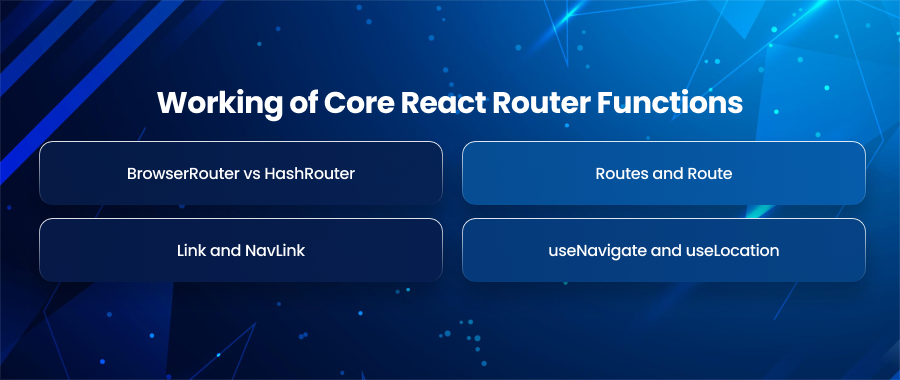
- BrowserRouter vs HashRouter
The BrowserRouter is best for applications with server-side rendering. It uses HTML5 history API to synchronize UI with the URL.
While the HashRouter uses a hash in the URL. It is best for static file servers and is best utilized when server support is limited.
- Routes and Route
Routes and Route define the navigation structure. Routes provide the way to select the right Route based on the URL. It renders the element component for the matched path.
<Routes>
<Route path=”/” element={<Home />} />
<Route path=”about” element={<About />} />
</Routes>
- Link and NavLink
The Link is used for navigation without page reloads, while NavLink brings in the styling factor to the link, such as highlighting the active link, enhancing UX, and clarity.
<Link to=”/about”>About</Link>
<NavLink to=”/about” activeClassName=”active”>About</NavLink>
- useNavigate and useLocation
useNavigate is a programmatic navigation that redirects you after a certain action, such as redirecting after a form submission. On the other hand, the useLocation provides you access to the current path. This helps in tracking navigation state or analytics.
Nested Routes and Layouts
With Nested Routes, you handle routing by exchanging specific view fragments based on the current Route. Moreover, it allows having child routes inside parent components.
<Route path=”dashboard” element={<DashboardLayout />}>
<Route index element={<Overview />} />
<Route path=”settings” element={<Settings />} />
</Route>
Dynamic Routing and URL Parameters
Handle dynamic routes by:
<Route path=”/user/:id” element={<UserProfile />} />
Get params with:
const { id } = useParams();
Wildcard routes:
<Route path=”*” element={<NotFound />} />
Lazy Loading with React Router
Split large apps into smaller bundles:
const About = React.lazy(() => import(‘./pages/About’));
<Route path=”about” element={
<Suspense fallback={<Spinner />}>
<About />
</Suspense>
} />
Best Practices for Implementing React Router
- Keep routing logic modular. For this, you need to break down your routing setup into smaller components or files. This keeps your codebase organized and maintainable.
- Use layout components for creating layout wrappers with <Outlet /> to avoid repeating code and support consistent nested UI structures.
- Don’t indulge in excessive nesting. Because deep nesting of routes will make your app harder to manage. It should be your utmost priority to keep the routing tree as flat as possible.
- Use <Link> to ensure smooth client-side navigation without full page reloads. This preserves your state and improves the performance.
- Use wrapper components or conditional logic with Navigate to restrict access to sensitive routes. This protects your routes based on authentication state.
Summary
To wrap up, React Router helps keep the structure of routing and provides flexibility in React applications. It features nested routing, dynamic parameters, lazy loading and protected routes to help developers make single-page applications that grow and perform well.
Hence, learning React Router makes your apps easy to navigate and enjoyable for users.






